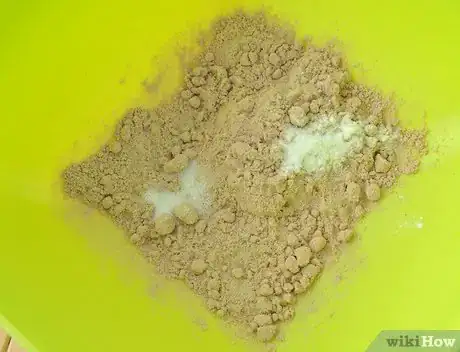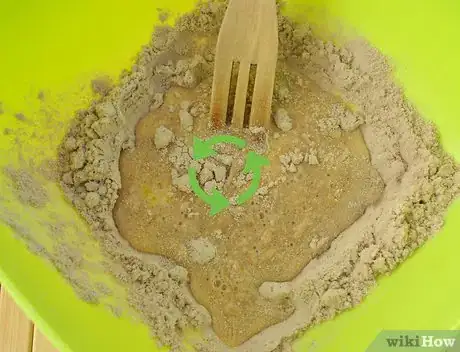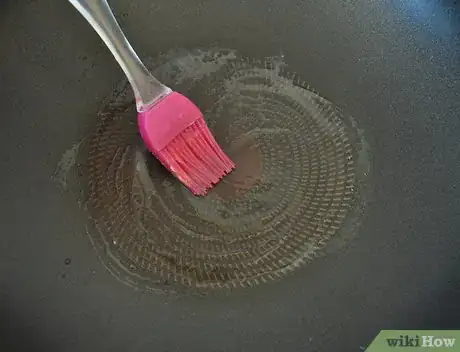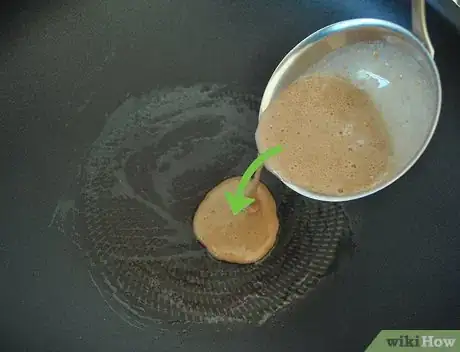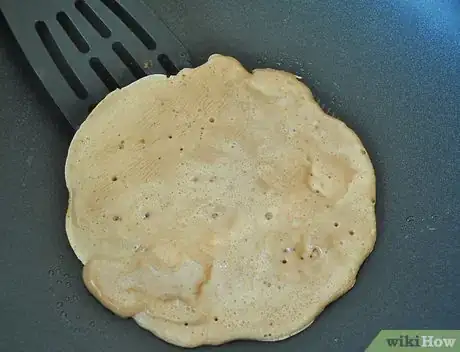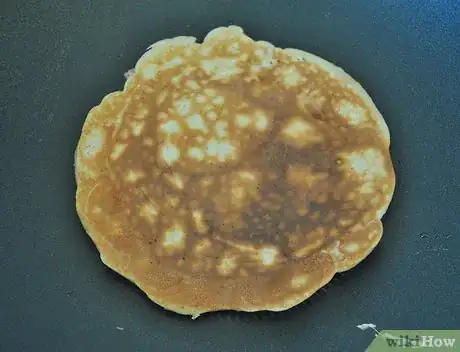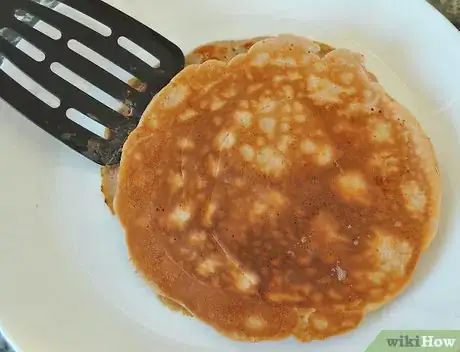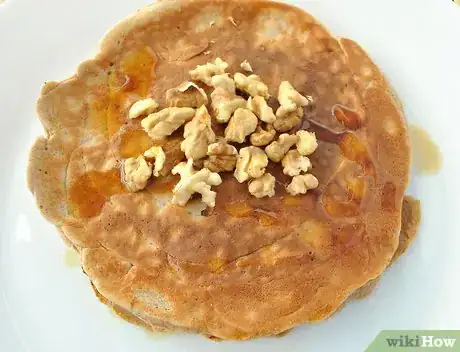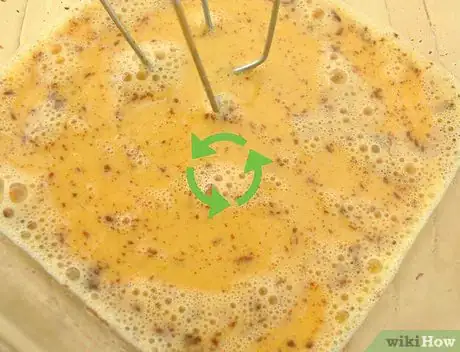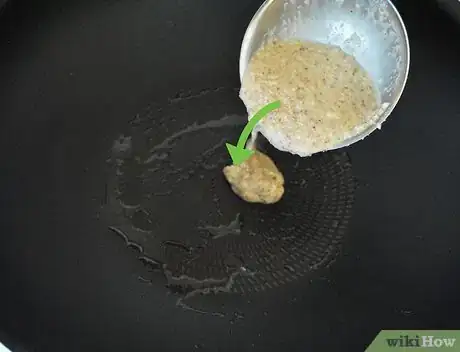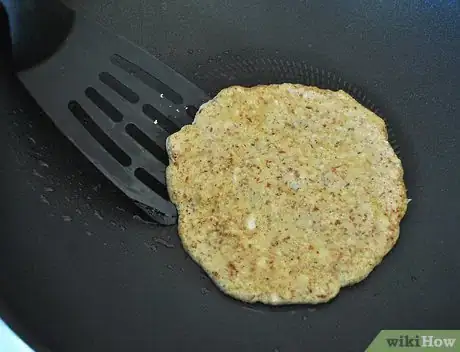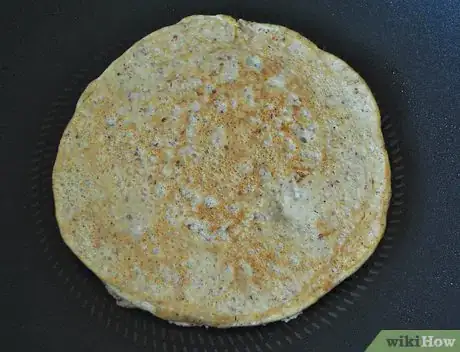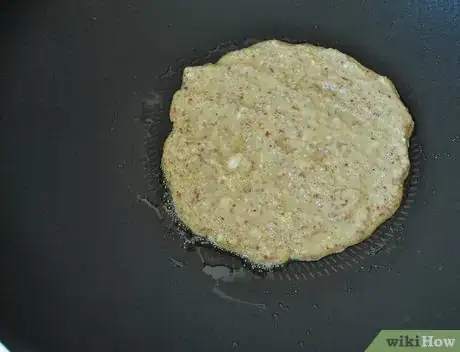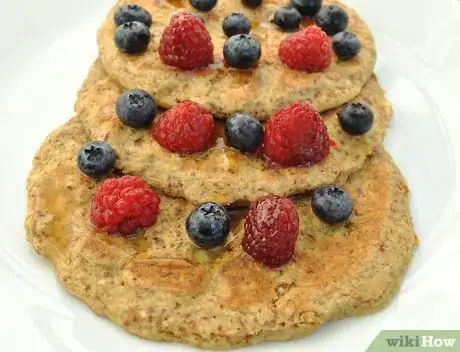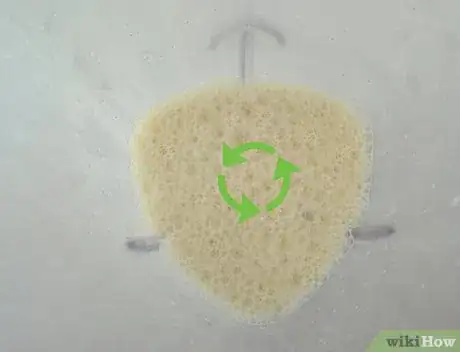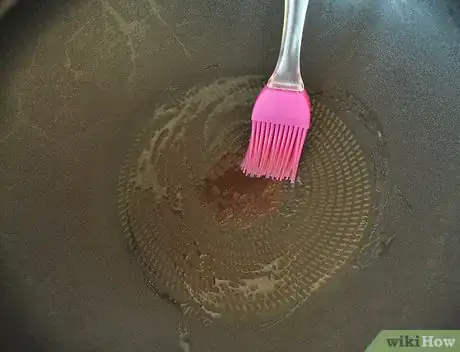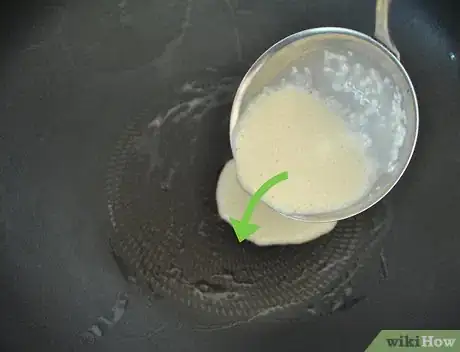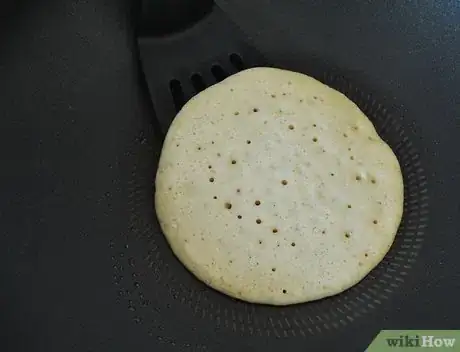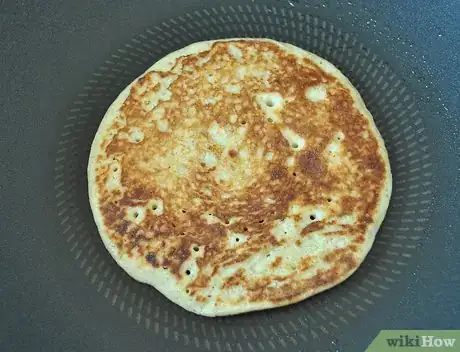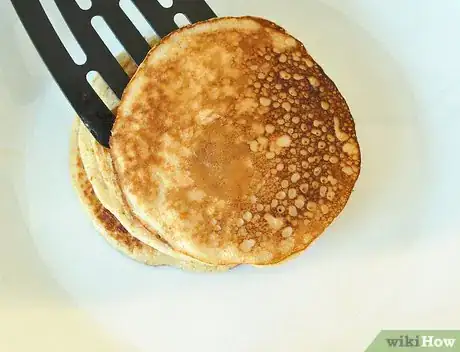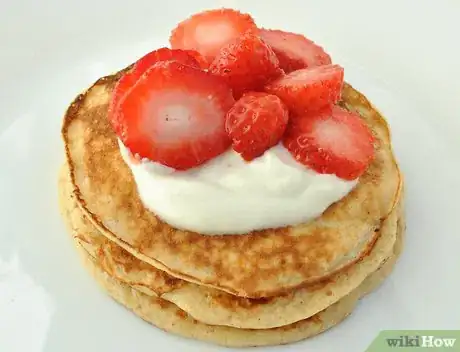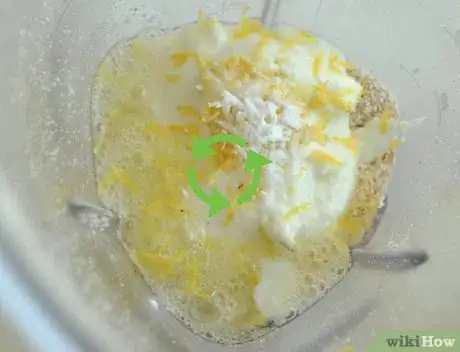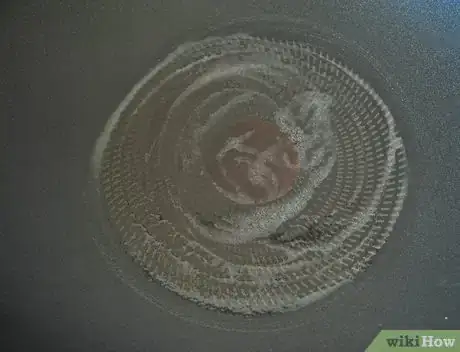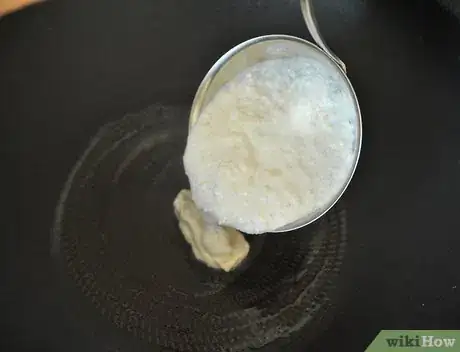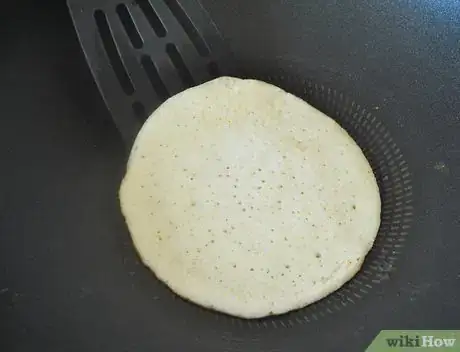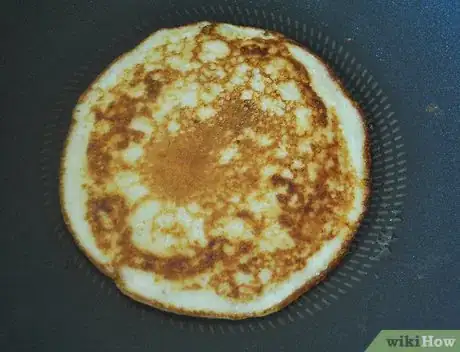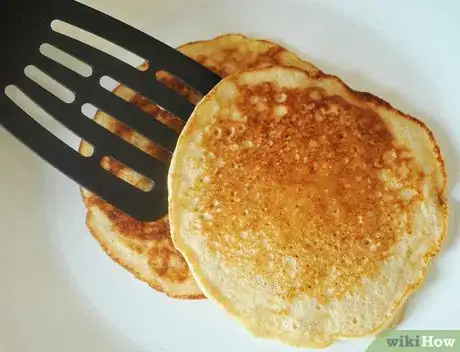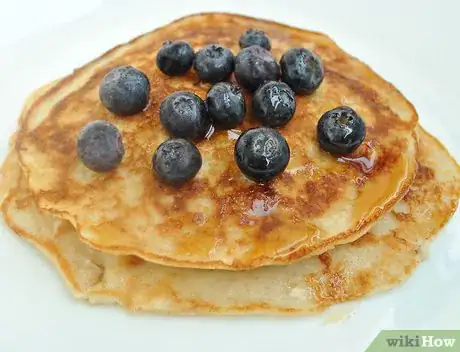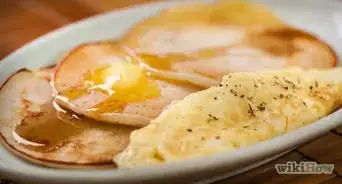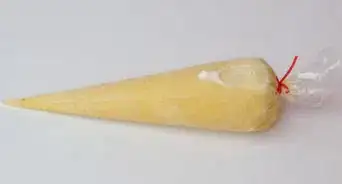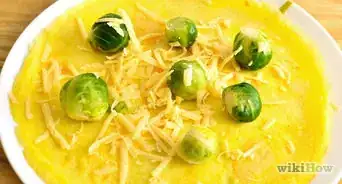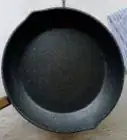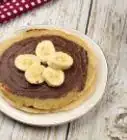This article was co-authored by Lisa Jubilee. Lisa Jubilee is a Certified Dietician-Nutritionist and the Co-Founder of Living Proof Nutrition Strength Pilates in New York City. With over 20 years of experience, she specializes in sustainable weight loss and disease prevention. She earned a Masters in Nutrition and Dietetics from New York University and a BS in Chemistry, Foods, and Nutrition from Rutgers University. She also published an e-book, Self Care = Health Care: A Health Empowerment Protocol From a Nutritionist’s Perspective. She has been ranked as one of the Best Nutritionists in New York City by Expertise.com since 2017.
This article has been viewed 253,265 times.
Pancakes are a popular, tasty breakfast treat. They can be packed with carbs, however, which can be a problem if you are on a low carb diet. Fortunately, there are lots of ways to make pancakes that are tasty, yet low in carbs.
Ingredients
- 2 egg whites or 2 whole eggs
- ⅔ cup (88 grams) protein powder
- ½ cup (120 milliliters) water
- ¼ cup (60 milliliters) cooking oil or butter
- ½ to 1 teaspoon baking powder
- Sugar substitute (optional).
- ¼ teaspoon salt (optional)
Makes 2 large or 6 small pancakes
- 2 eggs
- 1 teaspoon vanilla extract
- ½ teaspoon sea salt
- ½ teaspoon ground cinnamon (optional)
- 1¾ cups (168 grams) almond flour
- ¾ cups (180 grams) almond milk
Makes 10 pancakes
- 4 ounces (115 grams) cream cheese, softened
- 4 eggs
- 2 teaspoons vanilla extract
- 1 tablespoon (15 grams) sugar substitute, or more to taste
- 1 dash cinnamon (optional)
- ½ teaspoon maple extract (optional)
- 4 tablespoons (28 grams) coconut flour
- 2 teaspoons baking powder
- 1 to 2 tablespoons (15 to 30 milliliters) almond milk or half-and-half, if needed
Makes 8 to 10 pancakes
- Zest from 1 lemon
- 2 tablespoons (30 milliliters) juice from 1 lemon
- 1 cup (100 grams) rolled oats
- 1 cup (225 grams) low fat ricotta cheese
- 1 cup (250 grams) nonfat plain Greek yogurt
- ⅓ cup (81 grams) egg whites
- ½ teaspoon baking soda
- 1 tablespoon (22.5 grams) honey
Makes 15 pancakes
Steps
Making Protein-Packed Pancakes
-
1Combine the dry ingredients in a bowl. Pour the protein powder into a large mixing bowl. Whisk in the baking powder and the salt. If you want to make your pancakes sweeter, add in a little bit of your favorite sugar substitute (ie: Stevia).
- You can get protein powder sweetened or unsweetened. Consider getting the sweetened kind for this recipe. This way, you won't have to add extra sweetener to it.
- The salt is not absolutely necessary, but it can help cut the sweetness of overly-sweet protein powder.
-
2Stir the eggs and the liquid ingredients to the bowl. Pat down the dry mixture first, then make a well. Add the eggs, water, and oil into the well. Whisk everything together until just combined. If the mixture is still too thin, whisk in a little bit more protein powder.
- You can also use an egg substitute instead.
- For something more flavorful, switch out the water for a low carb milk substitute. You can also try sour cream or butter milk as well.
- Consider adding in some tasty extras, such as ground cinnamon, fruit, nuts, or pieces of cooked bacon.
Advertisement -
3Heat some oil or butter in a skillet. Heat the pan up first. When it's hot enough to make a fleck of water sizzle, add about ¼ tablespoon of butter or oil. Spread the oil or butter around, then wipe most of it off with a paper towel.
-
4Pour some batter onto the skillet. Use a soup ladle to measure out about ¼ cup (60 milliliters) of pancake batter and pour it onto the skillet. Depending on the size of your skillet, you may be able to fit more than one pancake, as long as they do not touch.
-
5Wait for the bubbles to form and burst before flipping the pancake over. This will only take 25 to 30 seconds. As soon as you see the bubbles, wait for them to burst, then slide a spatula under the pancake and flip it over.
-
6Cook the pancake until it turns golden-brown. This should only take about 25 to 30 seconds. Once the pancake is cooked, slide it off the pan and onto a plate.
-
7Make more pancakes. You have enough batter to make 2 large pancakes or 6 small ones. Re-grease the pan if it starts to turn too dry.
-
8Serve the pancakes. You can eat them as they are, or serve them with your favorite pancake syrup. Yogurt or sugar-free preserves are another tasty option. You can also sprinkle some sugar substitute, such as Stevia, on top.
Making Almond Flour Pancakes
-
1Mix together the eggs, vanilla, salt, and cinnamon. Crack open two eggs into a small mixing bowl. Add the vanilla extract and the salt. For extra flavor, add in ½ teaspoon of ground cinnamon. Stir everything together with a whisk until the yolks break and the color is even.
-
2Whisk in the almond flour and the milk. Measure out the almond flour and add it to the bowl. Pour the milk in next. Stir everything together with a whisk until everything is combined.
- Add another 1 to 2 tablespoons (15 to 30 milliliters) of almond milk of the batter is too thick for you.
-
3
-
4Pour ¼ cup (60 milliliters) of pancake batter onto the skillet. Depending on the size of the skillet, you may be able to fit more than one pancake—just be sure to leave some space between each one.
- A soup ladle is great for measuring out the water and pouring it.
-
5Cook the pancake for about 2 minutes before flipping it. Wait for bubbles to form on the pancake. Once the bubbles start to pop, slide a spatula under the pancake and flip it over onto the other side.
-
6Cook the pancake for another 2 minutes or so. The pancake is ready when it is golden-brown on both sides. Use a spatula to transfer the pancake from the skillet to a plate.
-
7Make the rest of the pancakes. Use about ¼ cup (60 milliliters) for each one. Re-grease the skillet after every couple of pancakes, and remember to wipe the excess grease off with a paper towel.
-
8Serve the pancakes. You can pour some maple syrup on top if you want a traditional meal. For something a little different, try whipped cream or sliced fruit.
Making Fluffy Cream Cheese Pancakes
-
1Blend together the first six ingredients. Place the cream cheese into a mixer. Add the eggs, vanilla extract, and sugar substitute. For extra flavor, add a dash of cinnamon and/or ½ teaspoon of maple extract. Blend everything together until combined.
- You can also use sugar-free vanilla syrup instead of vanilla extract.
- If you don't have a mixer, use a blender or food processor instead.
-
2Mix in the coconut flour and baking powder. Scrape down the sides of the bowl often to ensure that everything mixes in evenly. If the batter starts to thicken too much, add a splash of almond milk, half-and-half, or heavy cream.
-
3Heat and oil an a skillet over medium heat. Heat the pan over medium heat first. Once it's hot enough to make a bead of water sizzle, spread some oil, butter, or cooking spray over the surface. If you used butter or oil, be sure to wipe most of it off with a paper towel.[4]
-
4Pour some batter onto the skillet. Use enough batter to make a 4 to 6-inch (10.16 to 15.24-centimeter) wide pancake. This will typically be about ¼ cup (60 milliliters) of pancake batter. Depending on the size of your skillet, you may be able to fit more than one pancake—don't let them touch, however!
- Use a soup ladle or ice cream scoop to measure out the batter.
-
5Wait for the pancakes to develop bubbles before flipping them. Once the pancakes form crispy edges, and the bubbles pop, they are ready to be flipped. Slide a spatula under the pancake, then quickly flip it over onto the other side.
-
6Cook the pancake for another 2 to 3 minutes. It's ready when it's a golden-brown on both sides. Once it's ready, use the spatula to slide the pancake onto a plate.
-
7Continue making pancakes until you run out of batter. Every so often, you will need to re-grease the skillet. If you use oil or butter, be sure to wipe it off with a paper towel. This will prevent the pancakes from turning out too greasy or splotchy.
-
8Serve the pancakes. You can serve them as they are, or drizzle some maple syrup on top. You can also try them with whipped cream or sliced fruit!
Making Zesty Ricotta Pancakes
-
1Blend the rolled oats to make oat flour. Pour 1 cup (100 grams) of oats into a blender or food processor. Blend the oats until they form a fine mixture, like flour.
-
2Mix in the rest of the ingredients. Add in the ricotta, yogurt, egg whites, baking soda, and honey. At the very end, add in the lemon zest and the lemon juice. Mix everything together until well-combined. Use a rubber spatula to scrape down the walls of the blender/food processor occasionally to ensure that everything mixes evenly.
- ⅓ cup (81 grams) egg whites equals about 2 large eggs.
-
3Heat and grease a skillet over medium heat. Heat the skillet over medium heat until it's hot enough to make a drop of water sizzle. Next, grease it's surface with cooking spray, oil, or butter. If you used oil or butter, be sure to wipe most of it off with a paper towel. This will keep your pancakes from turning greasy and splotchy.[5]
-
4Pour some pancake batter onto the skillet. Plan on using about ¼ cup (60 milliliters) of batter. These types of pancakes are meant to be thin, but you can make them thicker if you want to.
- Use a soup ladle to make the pouring easier.
-
5Wait until bubbles form to flip the pancake. Once the edges of the pancake turn dry and the bubbles pop, use a spatula to loosen the edges. Carefully slide the spatula under the pancake, then flip it over.
- These pancakes are delicate compared to other types. Don't worry if your first few don't turn out perfect.
-
6Cook the pancake for 1 to 2 more minutes. It's ready when it's a golden color on both slides. Use a spatula to slide the pancake off of the pan and onto a plate.
-
7Continue making pancakes until you run out of batter. You have enough batter to make around 15 pancakes. How much you actually end up making also depends on the size and thickness of the pancakes.
- Re-grease the pan after every couple of pancakes. Remember to wipe any excess oil or butter off.
-
8Serve the pancakes. They taste delicious with syrup, Greek yogurt, and fresh blueberries. You can also use lemon curd instead.
Community Q&A
-
QuestionWhat kind of milk do I use for pancakes?
 Community AnswerAny kind of milk will do, but the different fat contents of milk lead to different pancake consistencies. If you choose to make your pancakes with skim milk, the pancake will end up drier and more rough on the palate, but healthier. If you choose to make them with 2 percent or whole milk, the pancake will turn out more moist and smooth.
Community AnswerAny kind of milk will do, but the different fat contents of milk lead to different pancake consistencies. If you choose to make your pancakes with skim milk, the pancake will end up drier and more rough on the palate, but healthier. If you choose to make them with 2 percent or whole milk, the pancake will turn out more moist and smooth. -
QuestionWhat is the nutritional composition of low carb pancakes?
 Community AnswerYour typical low-carb pancake with a diameter of six inches contains roughly 100 calories, 5g of fat, 15mg cholesterol, 170mg sodium, and 26g carbohydrates. In comparison, there are 45g of carbohydrates in regular pancakes, causing a decrease of 42%. These measurements will change depending on the individual recipe and ingredients.
Community AnswerYour typical low-carb pancake with a diameter of six inches contains roughly 100 calories, 5g of fat, 15mg cholesterol, 170mg sodium, and 26g carbohydrates. In comparison, there are 45g of carbohydrates in regular pancakes, causing a decrease of 42%. These measurements will change depending on the individual recipe and ingredients. -
QuestionHow do I make pancakes with hazelnut flour?
 Community AnswerThe process for making pancakes with hazelnut flour is no different from the process for making pancakes with regular flour. Just replace the flour in the recipe with hazelnut flour.
Community AnswerThe process for making pancakes with hazelnut flour is no different from the process for making pancakes with regular flour. Just replace the flour in the recipe with hazelnut flour.
Warnings
- Avoid foods to which you may be allergic (egg, soy, milk, etc.). Protein powders come from several sources like soy protein, milk whey protein, egg protein.⧼thumbs_response⧽
Things You'll Need
Making Protein-Packed Pancakes
- Mixing bowl
- Whisk
- Spatula
- Soup ladle
- Skillet
Making Almond Flour Pancakes
- Mixing bowl
- Whisk
- Spatula
- Soup ladle
- Skillet
Making Fluffy Cream Cheese Pancakes
- Mixer or blender
- Soup ladle
- Skillet
Making Zesty Ricotta Pancakes
- Blender or food processor
- Soup ladle
- Skillet
References
- ↑ https://www.artfrommytable.com/low-carb-ricotta-pancakes-recipe/
- ↑ http://dish.allrecipes.com/tips-for-better-pancakes/
- ↑ http://www.recipetineats.com/instant-classic-pancake-mix/
- ↑ http://www.recipetineats.com/instant-classic-pancake-mix/
- ↑ http://www.recipetineats.com/instant-classic-pancake-mix/
- ↑ https://minimalistbaker.com/how-to-make-a-flax-egg/
- ↑ http://dish.allrecipes.com/tips-for-better-pancakes/
- ↑ http://dish.allrecipes.com/tips-for-better-pancakes/
About This Article
To make low-carb pancakes, start by mixing protein powder, baking powder, and salt in a large bowl. Then, make a well in the middle of the dry ingredients and add eggs, water, and cooking oil into it. Next, mix all of the ingredients together and pour some of the batter onto a heated skillet with some oil on it. Finally, cook the pancake for around 30 seconds on each side before cooking the rest of the batter. To learn how to make other kinds of low-carb pancakes, like almond flour pancakes, scroll down!
